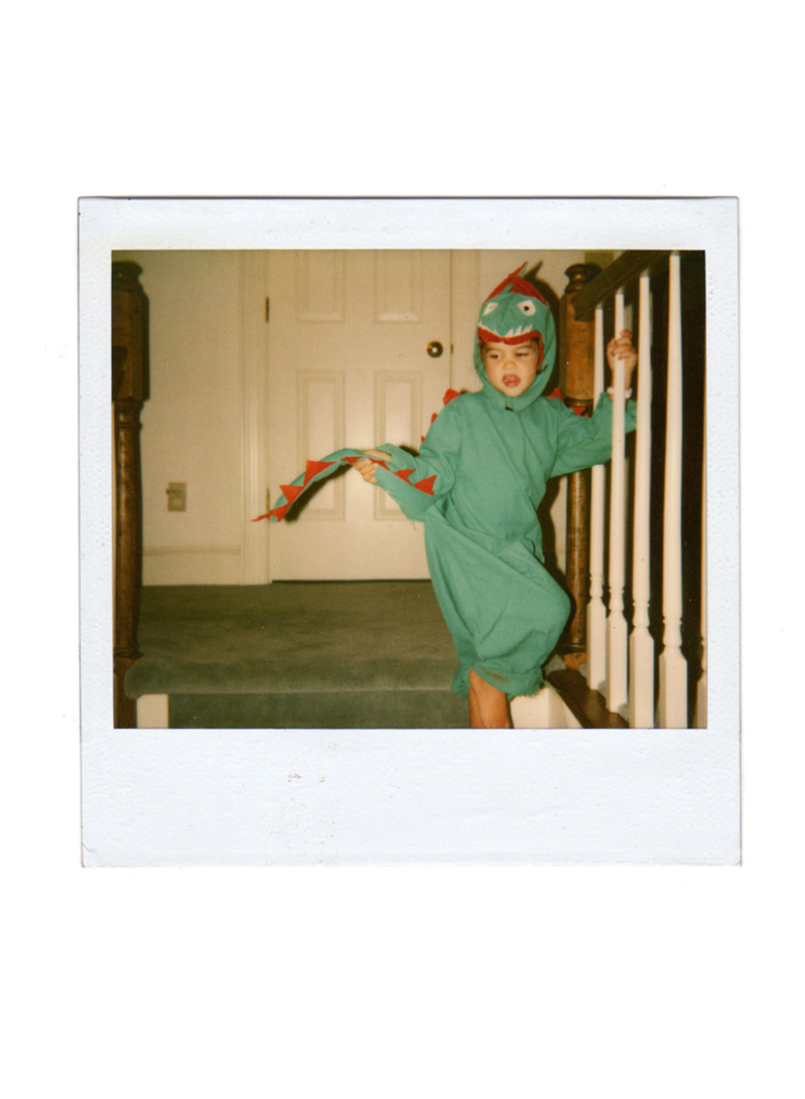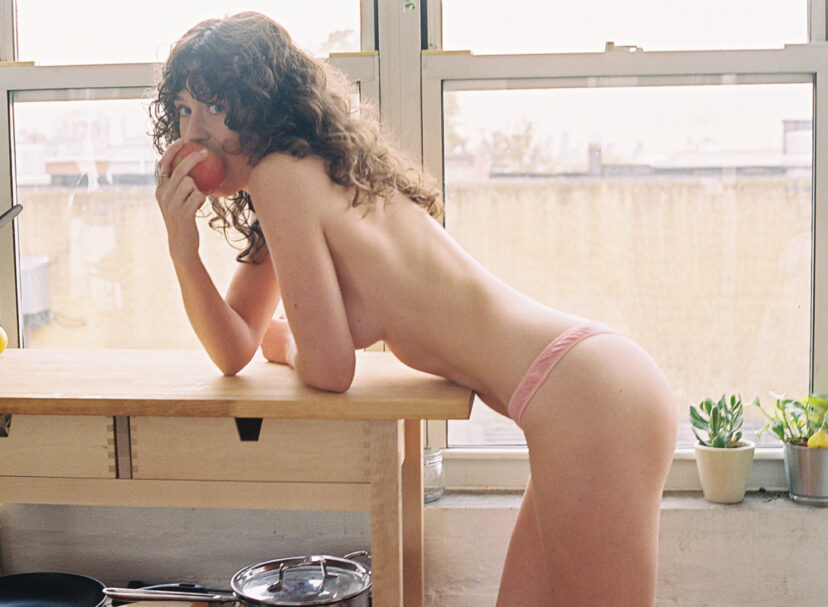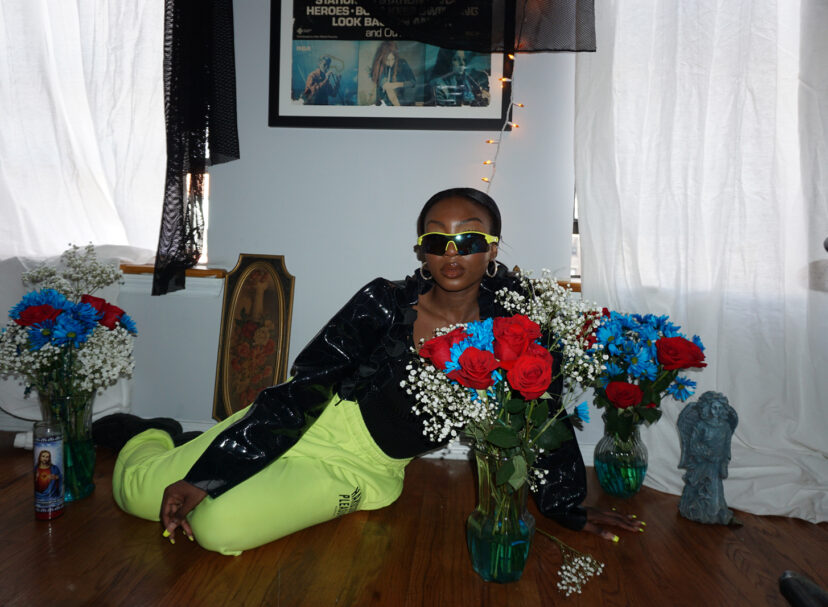Text & Interview: Monica Uszerowicz
Photo: Kat Slootsky
All Other Images Courtesy of Audrey Louise Reynolds
Color artist Audrey Louise Reynolds has a vibrant, commotive brain: she’s been endlessly curious and creative since babyhood when she’d escape from her crib to paint on bathroom mirrors. Later, she’d travel seashores by boat, attempting to identify every creature she could dig up from the sand. And while she didn’t end up becoming a world-traveling environmental philosopher (not exactly), Reynolds is, instead, a dye-maker and colorist, collaborating with designers like Pamela Love and Repetto and sourcing her colors from flowers, clay, seaweed, branches, and spices. Exploring, cooking, and working with nature suits her just fine, and every item in her line, ALR—from the dyes you can use yourself to her soft t-shirts stained with turmeric—is free of harmful chemicals. In our e-mail interview with Reynolds, she shared Polaroids and stories from her childhood, and how these moments from her youth led her to create her own world.




Do you remember being fascinated with the color and shape of objects as a child?
So into the color and shape of everything. That’s what and how I see since forever.
I would break out of my crib to draw and create with whatever was around. Check out this Polaroid from when I was less than a year old. Everyone thought I was napping, but I crawled into the guest bathroom where my Nana (the coolest) was staying. I somehow climbed up on the counter, opened the Vaseline, got cotton balls, stood up, and painted this. Instead of scolding me, my Nana, a painter herself, was very proud and took this Polaroid.
Here’s me at 1 and a half with a paintbrush. I used to mix plants I pulled from the garden into the water and paint the deck. When the deck was wet, it was darker, and when I mixed in plants and berries, there was an effect. My mom said it would sun-dry just in time for me to paint all over again. I would do this for hours on end.


Here’s a picture of one of my casual after-school looks. I liked very colorful gear and full face paint. I would dress like a dragon and ride a dragon pool float.
I was always making clothes, playing with science, and trying to make the world a better place, while still feeding my own creativity and curiosity.


I love that your work merges science and the arts. How does science—chemistry and biology—play into your practice, and what’s fascinating about it?
I have bad, unmedicated ADHD. Science holds my attention. I’m obsessed with being outside. As a child, I would walk around with those laminated identification cards and look for everything and photograph each discovery with my Polaroid camera. I would endlessly test our pool pH, so I could see the two clear liquids merge to form a color that meant something. I am good with hands-on learning, so I excelled here, rather than a class where someone just talks at you every day and you never do anything.
I find myself forming hypotheses and trying to solve them constantly. It’s pretty much my whole internal dialogue, breaking things down and looking around. So many questions. I also always have to make things with my hands 24/7—painting or sewing or writing or cooking or gardening or obsessing over my dog. I can’t sit still; then I just pass out and wake up at 5:30 or 6 and start again. Science has made me understand cooking through seeing viscosity, by understanding what’s actually happening in the process.
As an artist who’s obsessed with science and cooking, where do you go? I didn’t choose how to limit my artist palette and form a business until what I was doing for myself experimentally took off by word of mouth, and designers started hiring me as a collaborator. I quickly learned in the industry that choosing this path 14 years ago—to naturally dye as a business—had a real value and ability to push a very toxic industry back to the old ways, forcing new healthy standards of creating. Through running a dye house, I saw other people taking markups on my hand-done work and said, “Wow, I should have a product.”
Hypothesis I used to form my company:

Can you describe, technically speaking, the process of dyeing, from the seeking of materials for color to the creation of the dye itself?
Below is a brand new diagram for my natural dye pack products. I had my friend Matt Nelson draw out each step, as we now ship worldwide but don’t offer instructions in every language. You can see how easy it is to use. This is what I would consider the simplest form of natural dyeing available. After this, it gets as complex as you allow it. Cherry Blossom dye, for example, takes me about two months to extract the brightest form of the pink that exists inside the tree.If you were to just boil the branches, you could lose the color, turning everything brown. Life is fragile, as is the color of a living thing. To harness that color at its fullest potential, even after years, has become this endless game I can play with nature.
The processes and technical steps are very important. They require a lot of care. When you mess that up, sometimes you get the most awesome surprise present and your head explodes, or you just get a mundane brown shade and it was all for nothing.

I read in a Vanity Fair interview that you liked painting, but you didn’t like the harmful materials in paint. What led you to do this sort of work? You’re completely self-taught.
In natural dyes and in making my own paints, I am self- taught. But in a few lessons that led me there—that was my Nana.
I grew up with an oil painter grandmother. She made me aware that not all of the pretty colors had ingredients that were okay to use. There were some paints I had to avoid, like those containing cadmium, cobalt, mercurial sulfides, and lead. Linseed oil and natural pigments, however, are fine for you, so my palette was limited to the things that aren’t harmful. We would set up still lifes and take pictures and then paint. We always had the Polaroids, because sometimes the work took so much longer to complete than the living fruit or flowers would last.
In ballet, I was forced to have my first encounter with rit dye, to make my shoes match my costume. I remember how terrible it smelled, how sick it made me feel, how we had to go out in the yard far away from the house and use a bucket my mom would throw away after because it had chemicals in it. I had to wear gloves. It was cool, changing the color, but I really felt distance from the work I was creating. I remember wanting to be hands-on and that fact that it was toxic seemed ridiculous to me, even at a young age. This never left my mind and is exactly why I created my natural DIY dye products.
Your business has grown, and I imagine you still do much of it yourself. How was the business expanded, in terms of working with new employees? What are the challenges associated with keeping things sustainable and small?
It’s grown so much. I have never learned and grown so much as having started this company. I still do so much myself; you’re right. Employee-wise, I’ve learned that everyone on my team should have unique skill sets that are their jobs, so there’s no confusion over who does what. Staying small is just a choice. They can’t be cranked out of a machine or made by any hands other than mine and be what they are. The products have value, because of the chain and the sustainable aspects and people involved. It’s actually so fulfilling, placing these growing orders and seeing other people I care about flourish and grow as a small business too. It’s a real community vibe with what we’ve got brewing all the time. The people and animals I work with all are happy making your product hopefully feel happier.
It’s not an option for me to make something that’s not responsible. I don’t want to put my name on any other sort of product. I only work with responsibly sourced materials, farm waste, three small family-owned USA organic cotton farms, one small family-owned USA alpaca farm, two seamstresses, one spinner, one weaver. I do all the dye-making and dyeing by hand. I have my accountant and bookkeeper. Interns in and out, and a freaking inbox that won’t quit. I feel blessed to be doing what I’m doing and humbled by how fucking hard it is every day.


Life is fragile, as is the color of a living thing. To harness that color at its fullest potential, even after years, has become this endless game I can play with nature.


In your collaboration with Jigsaw, you literally collaborated with nature. What are you working on now?
Thanks for noticing! Incorporating nature, a moment indifferent to my existence, I caught the rain; I was in the right place at the right time. That seems romantic to me, something more beautiful than I could ever calculate on my own. I love the patterns rain makes. I get hypnotized out there some days printing.
Right now, there’s just so much on my plate. But I love it; I’m hungry. Today, I’m designing Spring/Summer 2018 and producing Autumn/Winter 2017. I’m making a shot list for tomorrow night’s photo and video shoot, ghost- designing a few other companies S/S18, dyeing and swatching sampling other brands’ S/S18, shipping internet orders, store orders to fill, trying to get some emails done and finish this interview, plus go to the dentist in like, 35 minutes from now.
How do you keep yourself centered and calm running a business in a hectic city?
Am I calm and centered? Where’d you hear that load? 🙂 I think there’s a constant battle for balance. Some days have peace and balance; some days are just total chaos. Mostly, I think I’m just privileged to be doing what I’m doing, and I’m going to keep fighting every day to keep artists safe with great supplies, keep customers safe with healthy clothes, support small businesses I want to give my money to in my supply and production chain. I can live with all of those decisions, so that certainly helps me stay calm and centered. I truly just like people. I want them to do well and be well and create harmlessly.


